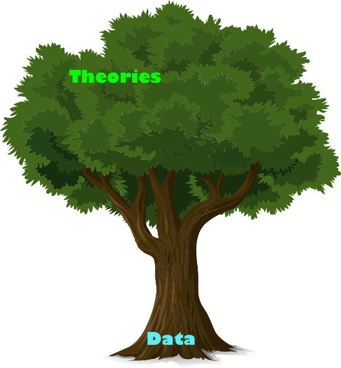Module 3 Chapter 2: Overview of Qualitative Traditions
In Chapter 1 you read about three different approaches to social work research: qualitative, quantitative, and mixed-methods approaches. In this chapter we examine different traditions and methods commonly utilized in qualitative approaches to research. The qualitative research literature presents a wide array of approaches: ethnography, life histories, symbolic interactionism, grounded theory, phenomenology, hermeneutics/heuristic research, interpretivism, collaborative social research, social or cognitive anthropology, case studies, narrative inquiry, critical inquiry, participatory action research, content analysis, study of artifacts, and participant observation (Creswell & Poth, 2018). Here, we examine four of the five approaches identified by Creswell and Poth (2018), as well as two other approaches. You will read about:
- Narrative research
- Phenomenological research
- Grounded theory research
- Ethnographic research
- Participatory action research
- Content/artifact analysis research
Qualitative Research Approaches
Qualitative research approaches are most appropriately used when the nature of the research questions and study goals meet certain criteria (Padgett, 2008). These include:
- Relatively little is known or understood about the topic of interest
- The topic involves stigma and/or taboos, thereby lending itself to analysis with emotional depth and sensitivity (rather than quantifiable facts)
- The goal is to study and create meaning from the perspectives of individuals who have “lived the experiences” of study interest
- The goal is to understand processes, particularly complex processes, in social work problems and practices/interventions
- The goal is to interpret quantitative research results, particularly unexpected results
- Engaging in action or participatory research, involving social action or advocacy in combination with conducting the research.
Common across qualitative approaches is employing the “researcher-as-instrument” (Padgett, 2008, p. 17). Qualitative research results are heavily influenced by the experiences, perceptions, and personal qualities of the investigator. Thus, a critical component involves the investigator being reflective about the data, participants, analysis process, and results.
Narrative Research. Narrative research “begins with the experiences as expressed in lived and told stories of individuals” (Creswell & Poth, 2018). It is about both the nature of the expressed narratives and exploration of the contexts in which the narratives and narrators are situated. The method of gathering and interpreting these stories is called narrative inquiry. This is typically performed with one or a very few individuals being involved with any one study. The purpose is to learn the individual stories and their meaning to individuals.

Of great interest in narrative inquiry is how a story is presented by the individual: it is seldom presented in a simple, chronological manner. Instead, stories are often conveyed in terms of critical transitions or nodal events where “turning points” occur in a person’s lived experience. Narrative examples are present in biographies, autobiographies (autoethnography), and oral histories. For example, the movie documentary Whitneypresents singer Whitney Houston’s stories and lived experiences as a performer, celebrity, and family member, including her relationship with alcohol and other drugs. Parts of the documentary are presented as others’ descriptions, parts are presented in her own words. The point is to better understand this person’s life.
A social work example of narrative inquiry is reported as one woman’s journey of recovery from mental illness (Thomas & Rickwood, 2016). Case interviews were conducted with a woman on three different occasions when she was (re)admitted to a residential mental health program. The woman’s narratives demonstrated changes over time in hope, self-identity, a meaningful life, and assuming responsibility for one’s own recovery. Furthermore, the investigators learned from the woman’s perspective what elements of the services provided were helpful in her road to recovery and that repeated admissions were less indicative of repeated failures and more about progress toward recovery.
Phenomenological Research. Like narrative research, phenomenological research involves recording the stories of individuals who experience a particular phenomenon or event of interest. Unlike narrative inquiry, however, phenomenology is about deriving or constructing a shared meaning about those events among a group of participants: the goal is “meaning making” (Oktay, 2012). The emphasis in this approach is placed on identifying what the participants and their shared stories have in common. The emerging phenomenological description is a composite description of the phenomenon.

Ideally, the investigator engages with a heterogeneous group of individuals, all of whom have experienced the phenomenon of interest. For example, if the phenomenon of interest is about the experiences of siblings to persons with intellectual disabilities, the investigator would want to engage with families of different ages, social or economic standing, religious and cultural background, sibling composition (numbers, genders, and spacing of siblings), and individuals with different types or severity of disability.
One example of this type of research is a qualitative study concerned with how trafficking affects the health and health care access among 15 women engaged in sex work in the red-light district (Kamathipura) of Mumbai, India (Karandikar, Gezinski, & Kaloga, 2016). The investigators worked with transcripts of interviews with the women, preserving the voice and language of the women who participated. They identified themes and relationships between themes in their coding of the data. Three themes were discussed in their manuscript: how participants first entered into sex work (all but two reported deception by family members, friends, or acquaintances as the pathway to prostitution); health problems experienced by the women (physical violence, sexually transmitted infection, alcohol addiction, tuberculosis, HIV infection, miscarriage, abortion, cough/cold, and malaria were most frequently reported as notable events); and, disparities in access to health care resulting from being captively held in isolation or seclusion to prevent escape from trafficking and stigma attached to sex work.
Grounded Theory Research. Grounded theory research develops theoretical explanations about a phenomenon or process being studied—in other words, moving beyond description to generating or discovering a theory (Creswell & Poth, 2018). The theory that emerges can then be tested using other approaches and methods to determine its generalizability. The name of this approach comes from the theory being “grounded” in the data, rather than the data being used to test a theory that has been presented “off the shelf” (Creswell & Poth, 2018, p. 82). This approach, first described as a unified approach by Glaser and Strauss (1967), is particularly relevant to social work:
Because grounded theory creates theories that are derived directly from real-world settings, it has the potential to produce theories that can be used by social workers to guide practice. This theory can also be used to develop theoretically based interventions that can be tested in practice settings. In fact, when grounded theory was developed, the authors envisioned a collaborative venture between researchers and practitioners to test and adapt the theory in practice settings” (Oktay, 2012, p. 5).
Grounded theory as an approach utilizes abductive reasoning, moving back and forth in an iterative manner between data gathering and analysis processes, including inductive and deductive logic in generating and cross-checking, testing the emerging theory (Oktay, 2012). Thus, theories grow from the grounded base of real-world data. The approach is heavily influenced by the discipline of sociology, but is used to inform other professions like social work and nursing. Study participants in grounded theory research are purposively selected because of their ability to provide relevant data.

An example of the grounded theory approach in use was presented in a study of professional decision-making processes undertaken by social workers in child protection roles (Kettle, 2018). Based on 22 interviews with social workers in Scotland, the investigator explored social workers’ own perceptions of negotiating delicate balances between the interests of children and adults; the past, present, and future; functioning as an investigator versus building a relationship; getting too close versus not close enough; and, having power over versus power together. Also studied was the nature of their transactions and exchanges with other professionals. Emerging theory emphasized social workers’ internal mental processes over rational-technical solutions for practice decisions, the role of perceived responsibility in degree of cooperation between professionals, and social workers’ perceptions of different family strategies for managing closeness of and power in their relationships with the social worker.
Ethnographic Research. Like the qualitative approaches that we have explored so far, ethnographic research aims to understand phenomena from the perspectives of those experiencing it. However, there exists a major difference: the unit of analysis in ethnographic research is a collective group where the individuals interact with one another and have shared, common experiences. As a result, the individuals become a “culture-sharing group” by virtue of the “shared patterns of behavior, beliefs and language” that they develop (Creswell & Poth, 2018, p. 90). Ethnographic research focuses on cultural systems, “operating on several levels simultaneously to infer the tacit rules of the culture or subculture from the myriad of actions and interactions being witnessed” (Padgett, 2008, p. 32). The approach is strongly influenced by the discipline of anthropology, but is critically important as an option for social work to understand diverse populations, social work problems, and social phenomena.

Helm (2016) described an ethnographic study of how practice decisions are made within and across a team of social workers when the judgments are made under conditions of subjectivity and uncertainty, and when the available information is incomplete, inconclusive, or possibly contested. The aim of the study conducted in Scotland was to learn about “sense-making” under these circumstances, with attention directed to how this becomes a shared activity, rather than an individual activity. The study participants included a single team manager, four team leaders acting as supervisors, and six social workers from the larger team of professionals working at the study location. Data were collected through the investigator’s direct,non-participatory observation of team member behavior, including what was said in the normal course of practice (naturalistic observation). The observation notes were coded for themes, the two strongest being “making sense through ‘framing’ the situation” and “constructing responsibility” (Helm, 2016, p. 29). Social work practitioners were observed to discuss cases with others, usually by opening the discussion with a framing statement, which then guided the discussion; for example, framing it in terms of the worker’s own feelings about a case situation. Marked differences were noted between how social workers framed their discussions with each other, in supervision, and with clients. In addition, the social workers’ sense-making occurred within the context of reference to their perceived professional roles and responsibilities. These perceptions were observed to influence decisions and actions by the social workers. The ethnographic observations help the profession better understand how practice decisions are made in complex, under-defined situations: in sense-making, individual practitioners rely on multiple sources of information, not the least of which is provided by their understanding of the professional context (roles and responsibilities) and input from co-workers and supervisors.
Ethnography might be an important approach for social workers to better understanding diverse populations in the ability/disability arena. Consider, for example, the meaning of a deaf culture. For hearing persons, not being able to hear and communicate through spoken language might seem like an overwhelming disability. For persons who have never been part of the dominant hearing culture, living and thriving in a deaf community is important and meaningful. Deaf culture is experienced as communicating and experiencing the world differently compared to the hearing community. Members of deaf culture do not view themselves as disabled and needing to be “fixed.” Similar discussions have emerged among individuals who experience the world differently than the mainstream by virtue of their neurodiversity experience. These are individuals, many diagnosed with autism spectrum or other neurological disorders, who advocate for recognizing and appreciating variations in functioning as just that, not as mental disorders or disabilities needing to be cured. Ethnographic research helps social workers better understand their lived experiences from a strengths perspective.
Participatory Action Research. Sometimes social workers are members of a group attempting to solve a problem or influence change at the mezzo or macro level; sometimes members of such a group engage social workers to help them promote the problem solving and change-making processes. Either way, the key stakeholders in problem solving or advocating for change may decide to integrate research methodologies into their process. The result might be a participatory action research (PAR) scenario. This is a type of research activity where investigators are engaged in dual roles, both as researchers and change agents in the group or process under study.
PAR is conducted in the context of a non-hierarchical, democratic, engaged partnership of decision-making at every point in the process. Together, stakeholders and social workers develop the aims, questions, methods, analyses, results, and reporting of the change process. The outcomes of PAR are locally relevant solutions, developed by key stakeholders empowered to act as local experts and co-researchers supported by relevant theory and research knowledge shared by social work practitioners in a collaborative, problem-solving process. The results often include enhanced research skills among the key stakeholder partners as a form of further empowerment. What is learned through the PAR collaboration may have generalizable knowledge applicable to other communities, but the generalizability is carefully interpreted since it is, essentially, a single case study at the community level. Lawson (2015) described the relevance of PAR in community development efforts:
“Homogenization is rooted in part in mainstream researchers’ claims about the wholesale generalizability of the knowledge gained from their investigations, and it is facilitated by the worldwide movement toward evidence-based policy and practice. Granting the importance, indeed the strengths, associated with this international development, there are manifest risks and dangers when local voices, choices, and knowledge are neglected, ignored, and discounted. Under these circumstances, rigorous research knowledge has the potential to serve as an instrument for domination, marginalization, and oppression. And when these conditions prevail, research-based knowledge has the potential to cause harm in the name of doing good work. PAR’s expressly local knowledge for locally tailored solutions thus provides an important safeguard and a quality assurance mechanism for policy and practice” (Lawson, 2015, p. ix-x).
Community-based participatory research (CBPR) is a type of participatory research involving a collaborative inquiry process. As above, local experts are “people other than formally trained researchers” engaged to share their good ideas about every aspect of the research being conducted: the questions asked, study design features, how results are interpreted, and how findings should be used (Lawson, 2015, p. xv). University-community collaborations often provide the context through which CBPR occurs.

An example of CBPR was a needs assessment concerning parenting support programs for fathers in Detroit, Michigan (Lee, Hoffman, & Harris, 2016). The key stakeholders engaged in the effort with trained social work investigators from a university’s school of social work included formal service delivery system providers, a community advisory board, other key informants, and fathers. The team proceeded through a five-stage community-engaged research process, and discussed the importance of operating as a “learning community” where team members function as both teachers and learners throughout the collaborative process.
Stage 1. Identification and assessment was centered around locating and interviewing formal service providers in the local community. As part of the interview process, additional providers were identified by the participants.
Stage 2. The team engaged in mapping nontraditional settings, as well. This was directed to identifying places where fathers might seek or receive parenting support outside of formal service delivery systems: barber shops, for example. They developed a map of the community served by formal and informal/nontraditional systems.
Stage 3. This phase was labeled “engagement & relationship building” (Lee, Hoffman, & Harris, 2016, p. 78). It involved creating a project community advisory board made up of key stakeholders, and developing working connections and relationships with researchers involved with this particular community.
Stage 4. At this point, key stakeholder and university partners collaborated to develop strategies and events to build the service providers’ capacity to provide parenting support as needed and desired by fathers in the community.
Stage 5. The final, evaluation stage involved trained investigators coding data, then stakeholders involved in checking/confirming the themes identified in the data (called “member checking” of results). This final phase also included dissemination of the study findings.
In the end, this CBPR project identified multiple themes and at least 15 recommendations. Service providers identified service needs of the community’s fathers and strategies for engaging fathers. The fathers identified themes around engaging with children and interacting with service providers. The recommendations are specific with regards to what can change to provide support for the parenting efforts of fathers in this community, and many are relevant to consider adopting in other communities.
Content or Artifact Analysis Research. Content analysis is not so much a qualitative approach as it is a means of analyzing qualitative data. The important distinction lies in the sources of data compared to studies where interviews are conducted. In content or artifact analysis, the investigator’s source of information is records or artifacts previously produced during or about the phenomenon of interest. Content analysis is typically conducted on artifacts that were created for naturally occurring reasons, rather than for purposes of the study being conducted. Historically, content analysis was frequently conducted with personal diaries and letters written to family members or close associates. Examples include studies of first-hand report artifacts concerning how military personnel experienced military combat or their experiences of being separated from family members.

Given the important role of media on socialization, contents of media to which individuals are exposed might be analyzed for common themes and messages that audiences might be receiving. For example, a social worker might be concerned with learning about the contents of books commonly read to young children in families expecting a new baby. Parents read these books as a form of “bibliotherapy” to inform their children about what to expect and socialize them about how to behave in relation to the expected or new family member. A content analysis of these books divulged a common structure and theme: the new baby’s arrival is initially met with a great deal of negative affect (jealousy, feeling neglected by parents, being annoyed by the baby’s behavior), then in the end the child has an epiphany whereby the baby is fun and becomes loved (Begun, unpublished). Unfortunately, this plot structure and theme approach is adult-centric—young children learn concepts not by the logical sequencing of events but by what is most salient, affect-laden, or recent. Therefore, the message to these children could be “don’t like the baby” as much as it is “like the baby” when exposed to these books.

Recent literature includes studies relying on content presented in social media postings as the studied artifacts (Facebook, twitter, Snapchat, MySpace, and others). For example, investigators reviewed the contents of more than 1,000 MySpace comments posted by adolescents and emerging adults (aged 13-24 years) for the presence of potential suicide statements (Cash et al, 2013). The content analysis resulted in identifying 64 messages where a theme of potential suicidality was present; these statements were associated with subthemes about relationships, mental health concerns, substance misuse, and suicide methods. The lesson learned from this study is that young people are expressing themselves about suicide-related thoughts and behaviors to their social networks using social networking sites. One implication is that individuals using social network sites might need to be educated about how to recognize, interpret, and respond to these types of messages to become part of a suicide prevention network.
Chapter Summary
In this chapter you read about different traditions of qualitative research. You were introduced to narrative, phenomenological, grounded theory, ethnographic, participatory action, and content/artifact analysis research traditions. In future chapters you will learn about the specific methods involved in data collection and engaging participants in qualitative research studies.
